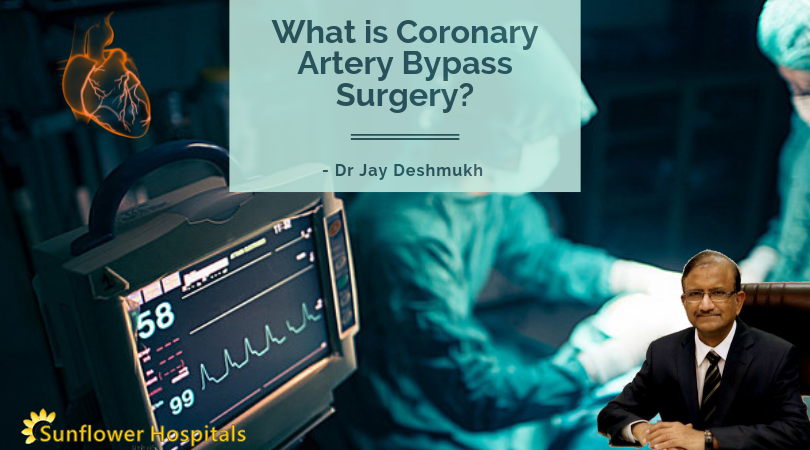CABG Sugary | Sunflower Hospital Nagpur | Dr Jay Deshmukh:- The first coronary artery bypass surgery was performed on 2 and May 1960 in the United States by a team led by Robert Goetz. CABG is a surgical procedure where the person’s own blood vessel is used to bypass an obstruction in the coronary artery and restore blood supply to the affected heart muscle.
What causes coronary artery obstruction?
- CABG Sugary | Sunflower Hospital Nagpur | Dr Jay Deshmukh:- Atherosclerosis of the artery caused by deposition of cholesterol, lipids and other cellular debris can cause obstruction to the flow of blood. The blood flow is limited if the cross-sectional narrowing is 50% or more. Atherosclerosis results in thickening, loss of elasticity and calcification of the arterial wall that results in obstruction and decreased flow to the heart muscle.
What are the predisposing factors for atherosclerosis?
- CABG Sugary | Sunflower Hospital Nagpur | Dr Jay Deshmukh:- Besides strong family history, hypertension, diabetes, high cholesterol, smoking, lack of exercises, obesity and mental stress are the few known factors. Controlling these risk factors can effectively reduce the chances of coronary obstruction.
What are the indications of coronary artery bypass surgery?
- CABG Sugary | Sunflower Hospital Nagpur | Dr Jay Deshmukh:- Obstruction in the left main, proximal left coronary artery, triple vessel disease, a diffuse disease not amenable by angioplasty are the few main indications. Multiple vessel disease in diabetics with a low heart pumping efficacy or ejection fraction is also considered as an indication.
What are the benefits of bypass surgery?
- CABG Sugary | Sunflower Hospital Nagpur | Dr Jay Deshmukh:- Bypass surgery can give relief from angina if angioplasty is not feasible. There is no survival benefit with bypass surgery vs medical therapy in stable angina pectoris. Bypass surgery cannot prevent future myocardial infarction.
What are the outcomes of bypass surgery?
- CABG Sugary | Sunflower Hospital Nagpur | Dr Jay Deshmukh:- Prognosis depends on many factors. A successful graft may remain patent for 8 to 15 years. CABG improves the chances of survival in patients who have had multiple blocks or major blocks. However after 5 years the survival rate in those who had surgery and those who were treated by medical therapy diminishes. Patients who had an arterial graft do better than those with venous grafts.
What are the different types of grafts?
- CABG Sugary | Sunflower Hospital Nagpur | Dr Jay Deshmukh:- The main graft is the joining of the left internal thoracic artery to the left anterior descending artery or LAD. The other could be the right internal thoracic artery to the right coronary artery or RCA. The leg veins that are the saphenous veins are used to bypass the obstruction by anastomosing them to the aorta and distally beyond the obstruction to the coronary artery. The saphenous grafts remain patent for a few years only. In a few radial arteries of the forearm is used. The success of the total arterial revascularization depends on the skill and experience of the surgeon.
What are the different types of bypass surgeries?
- The on-pump surgery involves using a heart-lung machine managed by a perfusionist where the heart is stopped and the heart-lung machine takes over. Once the bypass surgery is over the heart is restarted to beat effectively and the pump is withdrawn. In off-pump surgery, the surgeon places devices to stabilise the heart and the devices are removed after the grafting is done. Alternative methods of minimally invasive coronary artery bypass surgery have been developed.
How does bypass surgery compare with stent placement?
- CABG or stent placement are done to relieve symptoms of angina if medical therapy fails in relieving symptoms. CABG is superior to stents in some multi-vessel diseases. The incidence of strokes is higher in CABG than after stent placement. The need for revascularization is lower after CABG than after stent placement.
When can one lead a normal life after CABG?
- In most cases, patients can get back to their office work after 6 weeks. They can get back to their daily walks, exercises and travel after 2 months.
Do they need medicines after bypass surgery?
- In most of the blood thinners like aspirin and cholesterol-lowering statins are indicated on life long basis. Controlling diabetes, hypertension, excess weight, stopping tobacco, alcohol consumption and regular exercises are very important to prevent a recurrence.
What are the possible complications after bypass surgery?
- Infections, bleeding, acute renal failure, sudden cardiac arrest, death, sternal infections and keloid formation, transient memory loss are a few of them. With modern techniques and facilities, the major complications are less than 5 %. The outcome is good in most of the patients. Patients are discharged after 7 to 10 days.
CABG has come a long way as a robust and effective treatment for coronary artery diseases. The outcomes have improved with modern and effective supportive care. It is of greatest benefit in left main artery disease and in multiple vessel disease with poor left ventricular function.

